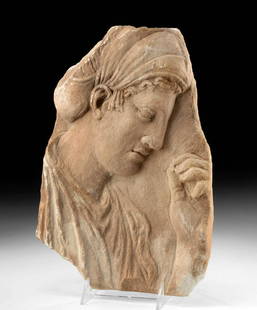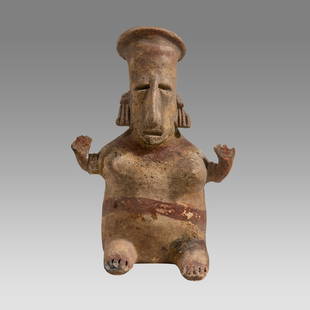
Torso of a child. Ancient Rome, ca. 3rd century A.D. Marble. The right arm is damaged and shows
Similar Sale History


Recommended Items









Item Details
Description
Torso of a child. Ancient Rome, ca. 3rd century AD.
Marble.
The right arm is damaged and has soil deposits.
Provenance: Acquired 1981 / Purchased at Bonhams, London, auction, 2008; Exhibited: University of Melbourne, Australia, March 1988 - July 2003 / Feriarte, IFEMA (Madrid, 16-24 November 2019).
Size: 35.5 x 16 cm / 65 cm high with stand.
This fragment of sculpture represents the body of a child with his right arm resting on his chest. The representations of naked children with these characteristics are usually of the god Eros in Greek mythology or Cupid in Roman mythology, who would be shooting an arrow with his right arm resting on his chest.
The Romans brought two important innovations to the world of sculpture: portraiture and historical relief, neither of which existed in the Greek world. However, they followed Greek models for much of their sculptural production, a basis which in Rome was combined with the Etruscan tradition. After the first contacts with Classical Greece via the Magna Graecia colonies, the Romans conquered Syracuse in 212 BC, a rich and important Greek colony in Sicily, which was adorned with a large number of Hellenistic works. The city was sacked and its art treasures taken to Rome, where the new style of these works soon replaced the Etruscan-Roman tradition that had prevailed until then. Cato himself denounced the looting and decoration of Rome with Hellenistic works, which he considered a dangerous influence on native culture, and deplored the Romans' applause of statues from Corinth and Athens, while ridiculing the decorative terracotta tradition of ancient Roman temples. However, these oppositional reactions were in vain; Greek art had subdued Etruscan-Roman art in general, to the extent that Greek statues were among the most coveted prizes of war, being displayed during the triumphal procession of the conquering generals. Shortly afterwards, in 133 BC, the Empire.
Marble.
The right arm is damaged and has soil deposits.
Provenance: Acquired 1981 / Purchased at Bonhams, London, auction, 2008; Exhibited: University of Melbourne, Australia, March 1988 - July 2003 / Feriarte, IFEMA (Madrid, 16-24 November 2019).
Size: 35.5 x 16 cm / 65 cm high with stand.
This fragment of sculpture represents the body of a child with his right arm resting on his chest. The representations of naked children with these characteristics are usually of the god Eros in Greek mythology or Cupid in Roman mythology, who would be shooting an arrow with his right arm resting on his chest.
The Romans brought two important innovations to the world of sculpture: portraiture and historical relief, neither of which existed in the Greek world. However, they followed Greek models for much of their sculptural production, a basis which in Rome was combined with the Etruscan tradition. After the first contacts with Classical Greece via the Magna Graecia colonies, the Romans conquered Syracuse in 212 BC, a rich and important Greek colony in Sicily, which was adorned with a large number of Hellenistic works. The city was sacked and its art treasures taken to Rome, where the new style of these works soon replaced the Etruscan-Roman tradition that had prevailed until then. Cato himself denounced the looting and decoration of Rome with Hellenistic works, which he considered a dangerous influence on native culture, and deplored the Romans' applause of statues from Corinth and Athens, while ridiculing the decorative terracotta tradition of ancient Roman temples. However, these oppositional reactions were in vain; Greek art had subdued Etruscan-Roman art in general, to the extent that Greek statues were among the most coveted prizes of war, being displayed during the triumphal procession of the conquering generals. Shortly afterwards, in 133 BC, the Empire.
Buyer's Premium
- 23%
Torso of a child. Ancient Rome, ca. 3rd century A.D. Marble. The right arm is damaged and shows
Estimate €3,500 - €4,000
2 bidders are watching this item.
Shipping & Pickup Options
Item located in Barcelona, -, esSee Policy for Shipping
Payment

Related Searches
TOP









































![[ITALIAN SCHOOL]. [UNKNOWN ARTIST]. St. Joseph and the Chri...: [ITALIAN SCHOOL]. [UNKNOWN ARTIST]. St. Joseph and the Christ Child [Ca. 18th/19th century]. Oil on canvas. Unsigned. 36 x 28”. Frame: 47 ½ x 40”. Lined. Craquelure overall. Inpaintin](https://p1.liveauctioneers.com/928/330686/178766064_1_x.jpg?height=310&quality=70&version=1716992685)






